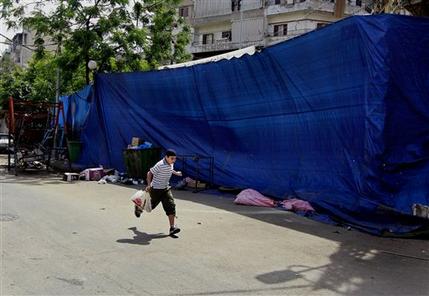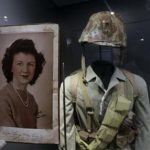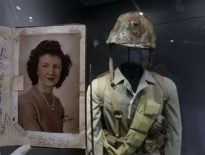TRIPOLI, Lebanon (AP) — In a rundown district of Lebanon’s second largest city, residents have adapted to waging war with their neighbors.

Whenever violence breaks out, they string large cloths across intersections to block snipers’ view, sleep in hallways to take cover from mortar shells and abandon apartments close to the front line.
Sectarian fighting between the two Tripoli neighborhoods, Bab Tabbaneh and Jabal Mohsen, goes back several decades, but these days it’s a proxy battle of the rival sides in Syria. Bab Tabbaneh is largely Sunni Muslim, like Syria’s rebels, while most people in Jabal Mohsen are Alawites, or followers of an offshoot of Shiite Islam, like Syrian President Bashar Assad.
The fighting between them has intensified since the start of the Syrian conflict more than two years ago. The latest round over the past week has been the bloodiest yet, leaving at least 28 dead and more than 200 wounded.
The escalating conflict in Tripoli is just one of the signs that the Syria fighting is increasingly spilling over into Lebanon, which is home to a fragile mosaic of more than a dozen religious and ethnic groups. Gunmen from rival religious sects have also gone to Syria to fight on opposite sides there.
Over the weekend, Lebanon’s Shiite militia Hezbollah, which has been fighting alongside Assad’s forces, said it would do battle until victory over Syria’s rebels. On Sunday, two rockets struck Hezbollah strongholds in Beirut, in apparent retaliation for Hezbollah’s support of Assad.
In Bab Tabbaneh, many say they are caught in the proxy war between the region’s Sunni and Shiite powers; Shiite-dominated Iran backs Assad, while influential Sunni state Saudi Arabia supports the rebels.
“Their problems are being played out here,” said Bab Tabbaneh resident Mohammed Bukhari, 53.
Bukhari’s second-floor apartment faces Jabal Mohsen, just a few dozen meters (yards) away. On May 19, when fighting broke out again, Bukhari moved with his wife, five children and two grandchildren into an empty apartment facing away from Jabal Mohsen.
“My own apartment is very dangerous,” he said, pointing to bullet holes in a wooden cabinet and an interior door.
Many leave for safer areas during the fighting.
Those who remain behind try to cope. They’ve strung large sheets of tarpaulin across streets that are otherwise exposed to snipers from Jabal Mohsen, blocking their aim.
One family, near the Bukharis, climbs out a second-floor back window and down a ladder to reach the street because the front entrance faces the front line.
Tempers flare quickly. On a recent morning, a young bread vendor who tried to set up his tray of goods near the local Harba mosque was quickly spotted as an outsider. A crowd of men, shouting and pushing him, accused him of being a Syrian spy and marched him to the mosque, where he was locked in a room.
Jabal Mohsen sits on a slope above Bab Tabbaneh. The Lebanese army has set up checkpoints around the Alawite neighborhood. Heading there is risky because of snipers.
Bab Tabbaneh is more safely accessible from the center of Tripoli. The Lebanese army moved two armored vehicles to the edge of Bab Tabbaneh over the weekend, but the deployment seemed largely symbolic.
During a visit Friday, local gunmen controlled the streets.
Some sat in groups on plastic chairs along the sidewalk of Syria Street, a main thoroughfare just a block from Jabal Mohsen. They were on a break, smoking and talking. Most of the fighting takes place after dark, when combatants fire machine guns, mortar shells and rocket-propelled grenades at each other.
Their current battle coincides with an offensive by Syrian troops and Hezbollah on Qusair, a predominantly Sunni town in western Syria.
The fighters offered a range of reasons for shooting at their neighbors, from defending their district to taking revenge for previous bloodshed or letting off steam against Assad and Hezbollah. But beyond inflicting as much pain as possible on the other side, there seemed to be no clear objective to the fighting.
Khaled Shahsheer, a 42-year-old taxi driver wearing camouflage, said unemployment and poverty in Bab Tabbaneh are feeding sectarian tensions.
Two others, who spoke on condition of anonymity for fear of retribution, said they are also settling old scores.
“We have a long blood account open with them,” said a 28-year-old money changer with a sniper rifle. “It’s not just about Qusair.”
The neighborhood forces clashed repeatedly during Lebanon’s 15-year civil war that ended in 1990. They fought again in 2008, after Hezbollah overran several Sunni neighborhoods in Beirut for a week and Tripoli’s Sunnis retaliated. Since the start of the Syria conflict, there have been more than a dozen rounds of fighting.
The money changer’s sniper position – a sandbag-reinforced hole poked into the wall of the neighborhood’s dilapidated “Andalus” cinema – goes back to the 2008 fighting. He said his grandfather was killed in clashes with Jabal Mohsen in 1979.
An 18-year-old with a patchy black beard and a Kalashnikov assault rifle had nothing good to say about Jabal Mohsen. “They don’t fear God, they are bad people,” he said of his neighbors.
The teen said he is one of 10 brothers who have taken up arms, including one who tried to join the Syrian rebels but was captured and killed by Assad’s troops.
Tripoli’s Alawites feel they face an existential threat. “The Alawites are being subjected to an organized campaign that aims to eliminate them on all levels,” Ali Feddah, a community leader, said earlier this month.
Alawites make up just 2 percent of the population in Lebanon and are surrounded by a large Sunni majority in Tripoli, a city of half a million people about 80 kilometers (50 miles) north of Beirut.
In Bab Tabbaneh, some said they can empathize with those on the other side.
“They also have children,” 45-year-old Bab Tabbaneh housewife Sahar Ashrafiyeh said of the Alawites. Bullets have hit her balcony and bedroom wall, and her exposed kitchen has made it hard for her to cook for her family of nine.
The Ashrafiyehs fled the neighborhood in 1985, after her husband Mahmoud was shot in the leg, she said. The family settled in Germany but returned in 1992, a decision her husband now bitterly regrets, she said.
Lebanese leaders have expressed concern about the risk of escalation. Referring to the clashes in Tripoli, President Michel Suleiman warned last week that “with our own hands we are turning Lebanon into an arena (of conflict).”
The Lebanese army has not been able to act decisively, in part because of Lebanon’s complex political constellations and because it does not have a monopoly on power – Hezbollah’s militia is a powerful rival.
In Tripoli, the government is particularly weak and the army, perceived here as Shiite-dominated, has to ensure local political support before moving in.
Some in Bab Tabbaneh take the fighting in stride. A Syrian refugee family living in two small rooms next to the Andalus cinema said Tripoli is still preferable to Homs, the battered Syrian city they fled 18 months ago.
In Homs, no one was safe from raids by pro-regime forces, said the father, who spoke on condition of anonymity because he did not want to endanger relatives back home.
“It’s better here,” he said. “They attack each other, but everyone stays in their place.”





